Sample Letter Of Reprimand For Insubordination
[Your Name]
[Your Title/Position]
[Your Company/Organization]
[Date]
[Employee's Name]
[Employee's Position]
[Employee's Department]
Dear [Employee's Name],
RE: Formal Letter of Reprimand for Insubordination
I hope this letter finds you well. It is with great regret that I must address a serious concern regarding your recent conduct at [Company/Organization]. The purpose of this letter is to formally reprimand you for the act of insubordination, which occurred on [date].
As you are aware, one of the fundamental principles that govern our workplace is the importance of maintaining a respectful and cooperative environment. Every employee is expected to follow the established policies, procedures, and instructions from their superiors. Unfortunately, your actions on [date] were in direct violation of these expectations, and it is essential to address this matter promptly.
The specific incident of insubordination occurred when [describe the incident in detail, including the context and individuals involved]. Despite clear instructions from your supervisor, you refused to comply with the directive, displaying a lack of respect for authority and undermining the team's cohesion.
It is important to emphasize that such behavior is not acceptable in any professional setting. Insubordination not only disrupts the workflow but also sets a detrimental example for other team members. We, as a company, place high value on a cooperative and respectful work environment where all employees are expected to act with professionalism and adhere to the chain of command.
I want to remind you that open communication and dialogue are always encouraged at [Company/Organization]. If you have concerns or disagreements, there are appropriate channels to address them, such as discussing the matter with your immediate supervisor or seeking resolution through our established grievance procedures.
In light of this incident, we expect immediate improvement in your behavior and conduct. Failure to do so may result in further disciplinary action, up to and including termination of your employment. We genuinely hope that this letter serves as a reminder of the importance of adhering to the company's policies and maintaining a positive and productive work atmosphere.
Moving forward, we encourage you to reflect on your actions and consider how your conduct affects not only your own professional reputation but also the overall success of our organization. It is our sincere hope that you will take this letter as an opportunity for growth and a chance to demonstrate your commitment to being a valuable and cooperative member of our team.
Please sign and return a copy of this letter to indicate that you have received and understood its content. If you wish to discuss this matter further, please schedule a meeting with me at your earliest convenience.
Sincerely,
[Your Name]
[Your Title/Position]
[Your Company/Organization]
--------------------------------------------------------------
[Employee's Signature] [Date]
Formal Letter of Reprimand for Direct Insubordination
Subject: Written Reprimand for Insubordination
Dear [Employee Name],
This letter serves as a formal written reprimand for your act of insubordination that occurred on [Date]. Specifically, you refused to comply with a direct and reasonable work instruction given by [Supervisor Name/Title] to [describe the task/instruction].
At approximately [time], you were instructed to [specific instruction]. You responded by [describe the insubordinate behavior - refusing, arguing, walking away, etc.]. This behavior constitutes a clear violation of company policy regarding respect for authority and compliance with reasonable work directives.
Your refusal to follow this legitimate instruction disrupted workflow, set a negative example for other team members, and undermined managerial authority. Such conduct is unacceptable and will not be tolerated.
This written reprimand will be placed in your personnel file. Any further instances of insubordination or similar misconduct may result in more severe disciplinary action, up to and including termination of employment.
You are expected to comply with all reasonable work instructions from your supervisors immediately. If you have concerns about a directive, you should follow it first and then raise your concerns through proper channels afterward.
Please sign below to acknowledge receipt of this reprimand. Your signature does not indicate agreement, only that you have received and read this document.
Sincerely,
[Manager Name]
[Title]
[Date]
Employee Signature: _________________ Date: _________
Professional Letter of Reprimand for Disrespectful Conduct
Subject: Written Reprimand for Disrespectful and Insubordinate Behavior
Dear [Employee Name],
I am writing to formally address your inappropriate and disrespectful conduct toward [Supervisor/Manager Name] on [Date]. This behavior constitutes insubordination and violates our workplace standards.
During the [meeting/interaction] on [Date], you [describe specific disrespectful actions: raised voice, used inappropriate language, made dismissive gestures, etc.] when [Supervisor Name] provided you with feedback regarding [issue]. Your response included [specific words or actions], which was wholly unprofessional and disrespectful.
Regardless of any frustrations you may have been experiencing, such behavior is never acceptable in our workplace. All employees are expected to treat supervisors and colleagues with respect, even during disagreements or difficult conversations.
This is a formal written warning. A copy will remain in your personnel file for [time period]. Should similar behavior occur again, you will face additional disciplinary measures, potentially including suspension or termination.
I encourage you to reflect on this incident and commit to professional conduct going forward. If you are experiencing workplace challenges that contributed to this behavior, I invite you to discuss them with Human Resources through appropriate channels.
Please acknowledge receipt of this letter by signing and dating below.
Sincerely,
[Manager Name]
[Title]
Employee Acknowledgment: _________________ Date: _________
Serious Letter of Reprimand for Repeated Insubordination
Subject: Final Written Warning - Repeated Insubordination
Dear [Employee Name],
This letter constitutes a final written warning regarding your continued pattern of insubordinate behavior. Despite previous verbal counseling on [Date] and a written warning on [Date], you have again demonstrated refusal to follow reasonable management directives.
On [Date], you were instructed by [Supervisor Name] to [specific instruction]. You openly refused this directive in front of other staff members, stating [quote or paraphrase the refusal]. This marks the third documented instance of insubordination in [time period].
Your pattern of behavior includes:
- [Date]: [Brief description of incident]
- [Date]: [Brief description of incident]
- [Date]: [Current incident]
This ongoing defiance of supervisory authority is unacceptable and has created a disruptive work environment. Your actions undermine team morale, waste management time and resources, and violate fundamental employment expectations.
This is your final warning. Any additional instance of insubordination, refusal to follow reasonable work instructions, or disrespectful conduct toward supervisors will result in immediate termination of your employment.
You are required to meet with Human Resources and your direct supervisor on [Date] at [Time] to discuss performance expectations and develop an improvement plan. Failure to attend this meeting will be considered job abandonment.
This letter will be placed permanently in your personnel file.
Sincerely,
[Manager Name]
[Title]
[HR Representative Name]
[Title]
Employee Signature: _________________ Date: _________
General Letter of Reprimand for Challenging Authority
Subject: Written Reprimand - Insubordinate Conduct
Dear [Employee Name],
This letter is to document and address your insubordinate behavior that occurred on [Date] during [situation/location].
When [Supervisor Name] asked you to [task or instruction], you responded by [describe the challenging behavior: questioning authority publicly, refusing outright, arguing extensively, etc.]. While we encourage open communication and value employee input, the manner in which you challenged this directive was inappropriate and disrespectful.
The specific concerns with your conduct include:
- Refusing a reasonable work assignment without legitimate justification
- Responding in a confrontational manner
- Displaying defiance in front of colleagues
- Failing to use proper channels for expressing concerns
We value your contributions to the team, but compliance with reasonable supervisory instructions is a fundamental requirement of your position. If you have legitimate concerns about a work directive, company policy provides appropriate channels for addressing them.
This written reprimand serves as formal notice that such behavior must cease immediately. Continued insubordination will result in progressive disciplinary action.
We expect your full cooperation and professional conduct moving forward. Please contact Human Resources if you have questions about workplace policies or appropriate communication channels.
Acknowledge receipt by signing below.
Sincerely,
[Manager Name]
[Title]
Employee Signature: _________________ Date: _________
Provisional Letter of Reprimand for First-Time Insubordination
Subject: Written Counseling - Insubordinate Behavior
Dear [Employee Name],
I am writing to address a concerning incident that occurred on [Date]. This letter serves as a formal written counseling regarding your refusal to follow a work instruction from [Supervisor Name].
On the date mentioned, you were asked to [describe the instruction]. Your response was to [describe the refusal or inappropriate response]. While this is your first documented instance of insubordination, it is a serious matter that requires immediate attention.
I recognize that you have generally been a reliable employee, which is why this behavior was particularly surprising. However, regardless of circumstances, refusing direct work instructions from your supervisor is unacceptable.
This letter is a formal counseling notice rather than a punitive reprimand. It will be placed in your personnel file for [time period, e.g., 6 months] and will be removed if no further incidents occur during that time.
I want to understand if there were underlying issues that contributed to this situation. Please schedule a meeting with me within the next three business days so we can discuss this incident and ensure it does not happen again.
Going forward, you are expected to comply with all reasonable work directives. If you have concerns about any instruction, please follow it first and then raise your concerns through proper channels.
I am confident this was an isolated incident and that we can move forward positively.
Sincerely,
[Manager Name]
[Title]
Employee Signature: _________________ Date: _________
Official Email of Reprimand for Insubordination During Remote Work
Subject: Formal Written Reprimand - Insubordination
Dear [Employee Name],
This email serves as formal documentation of insubordinate behavior during our remote work arrangement.
On [Date], during a video conference meeting at [Time], you were directed by [Supervisor Name] to [specific instruction]. You responded by [describe behavior: disconnecting from the call, refusing via chat/email, verbally declining, etc.]. Additionally, you failed to respond to subsequent emails and calls regarding this matter for [time period].
Remote work requires the same level of professionalism and compliance with supervisory direction as in-office work. Your refusal to complete assigned work and your failure to communicate professionally are serious violations of company policy.
This written reprimand is being issued and will be placed in your personnel file. You are required to:
1. Complete the originally assigned task by [deadline]
2. Attend a mandatory meeting via video conference on [Date] at [Time]
3. Demonstrate immediate improvement in responsiveness and cooperation
Failure to comply with these requirements or any future instance of insubordination will result in escalated disciplinary action, including possible termination.
Please reply to this email within 24 hours to acknowledge receipt and confirm your understanding of these expectations.
Sincerely,
[Manager Name]
[Title]
CC: [HR Department]
Formal Letter of Reprimand for Insubordination with Safety Implications
Subject: Immediate Written Reprimand - Refusal to Follow Safety Protocol
Dear [Employee Name],
This letter serves as an immediate formal reprimand for your serious act of insubordination involving safety procedures on [Date].
You were specifically instructed by [Supervisor Name] to [safety-related instruction, e.g., wear protective equipment, follow lockout/tagout procedures, cease unsafe operation]. You openly refused this direct safety instruction, stating [quote or describe refusal].
Your refusal to comply with safety directives is extremely serious. Such behavior not only violates company policy but also endangers yourself, your coworkers, and potentially our entire operation. Safety instructions are non-negotiable and must be followed without exception.
This incident represents both insubordination and a safety violation, two of the most serious infractions an employee can commit. The potential consequences of your refusal could have been catastrophic.
This written reprimand will remain permanently in your personnel file. You are hereby placed on a [time period] probationary period. During this time:
- You must complete mandatory safety retraining by [Date]
- You will be subject to increased supervision
- Any further safety violations or insubordination will result in immediate termination
Workplace safety is our highest priority. Your immediate compliance with all safety protocols is required to maintain your employment.
Acknowledge receipt by signing below.
Sincerely,
[Manager Name]
[Title]
[Safety Officer Name]
[Title]
Employee Signature: _________________ Date: _________
What is a Letter of Reprimand for Insubordination and Why is it Needed
A letter of reprimand for insubordination is a formal written document issued by an employer to an employee who has refused to follow reasonable work instructions, shown disrespect toward supervisory authority, or otherwise defied legitimate managerial directives. This letter serves multiple critical purposes:
- Creates official documentation of the employee's misconduct for personnel files and potential legal protection
- Establishes a clear record of the incident, the company's response, and expectations going forward
- Provides formal notice to the employee that their behavior is unacceptable and must change
- Initiates or continues progressive discipline procedures as outlined in company policy
- Protects the organization legally by demonstrating proper disciplinary procedures were followed
- Sets clear expectations for future conduct and outlines consequences of continued misconduct
- Preserves managerial authority and workplace order by addressing challenges to supervision
- Demonstrates fairness by providing written notice and opportunity for improvement before more severe action
When Should a Letter of Reprimand for Insubordination Be Issued
A reprimand letter for insubordination should be issued in the following situations:
- Direct refusal to perform assigned work tasks that are reasonable and within the employee's job description
- Open defiance of supervisory instructions in front of other employees, undermining authority
- Disrespectful or hostile responses to management directives, including aggressive language or behavior
- Repeated questioning or arguing about legitimate work instructions beyond reasonable clarification
- Failure to comply with workplace policies after being directly instructed to do so by a supervisor
- Walking away or ignoring a supervisor when given a direct work instruction
- Public challenges to management decisions done in an unprofessional or disrespectful manner
- Refusal to attend required meetings or participate in mandatory work activities
- Insubordination during remote work, including disconnecting from calls or ignoring digital directives
- Safety-related defiance, refusing to follow safety protocols or use required protective equipment
- After verbal warnings have been ineffective and the behavior continues or escalates
- When the incident is severe enough to warrant skipping verbal warnings in progressive discipline
Who Should Send a Letter of Reprimand for Insubordination
The appropriate sender depends on organizational structure and the severity of the incident:
- Direct supervisor or immediate manager for standard insubordination incidents within their department
- Department head or senior manager for more serious incidents or when the direct supervisor was the target
- Human Resources manager in conjunction with the employee's supervisor for significant violations
- Site manager or general manager for severe incidents affecting multiple departments or overall operations
- Company owner or executive in small businesses or for extremely serious violations
- Joint authorship from both HR and the employee's manager for final warnings or serious incidents
- Higher-level management when the insubordination involved the employee's direct supervisor to maintain objectivity
The sender must have direct authority over the employee and knowledge of the incident. Documentation should be reviewed by HR before issuance to ensure policy compliance and legal soundness.
Requirements and Prerequisites Before Issuing a Reprimand Letter
Before writing and sending a letter of reprimand for insubordination, ensure the following:
- Verify the incident occurred through direct observation, credible witnesses, or documented evidence
- Confirm the instruction was reasonable and within the employee's job scope and capabilities
- Review company policies on progressive discipline and ensure proper procedures are followed
- Check the employee's personnel file for previous incidents, warnings, or disciplinary history
- Ensure consistency by verifying similar incidents have been handled in comparable ways
- Gather all relevant documentation including dates, times, witnesses, and specific details of the incident
- Consult with HR department to ensure legal compliance and proper wording
- Determine appropriate discipline level based on severity and the employee's history
- Review the employee's contract or union agreement for any specific disciplinary procedures required
- Prepare for employee response including potential grievances, explanations, or disputes
- Identify witnesses who can corroborate the incident if needed for future proceedings
- Ensure objectivity by removing personal feelings and focusing solely on the behavior and policy violation
How to Write and Send a Letter of Reprimand for Insubordination
Follow this systematic process for creating and delivering the reprimand:
Writing Process:
- Use clear, objective language describing specific behaviors without emotional or judgmental terms
- State facts precisely including dates, times, locations, and exact nature of the insubordination
- Reference company policies that were violated to establish the legitimate basis for discipline
- Describe the impact of the behavior on operations, team morale, or workplace order
- Outline expectations for future conduct in clear, unambiguous terms
- Specify consequences of continued or repeated insubordination
- Include next steps such as required meetings, training, or probationary periods
- Request acknowledgment through signature or written response
Delivery Process:
- Schedule a private meeting in a confidential location, never deliver publicly
- Include an HR representative or witness when appropriate for documentation and fairness
- Present the letter calmly and professionally without anger or personal attacks
- Allow the employee to read the entire document before discussing
- Give opportunity for response but remain firm on the disciplinary decision
- Obtain signature acknowledging receipt (not necessarily agreement)
- Provide a copy to the employee immediately
- File the original in the personnel file with all supporting documentation
- Update relevant systems and inform necessary parties on a need-to-know basis
Elements and Structure of an Insubordination Reprimand Letter
Every letter of reprimand for insubordination should include these essential components:
- Professional header with company letterhead, date, and recipient information
- Clear subject line identifying the letter as a formal reprimand for insubordination
- Opening statement explicitly stating the letter's purpose and disciplinary nature
- Specific incident description with precise dates, times, locations, and factual account of behavior
- Direct quotes or detailed descriptions of what the employee said or did
- Policy violations referenced with specific company rules or procedures that were broken
- Impact statement explaining how the behavior affected operations, team, or organization
- Disciplinary action section clearly stating what level of discipline is being imposed
- Expectations for improvement with specific behavioral changes required
- Consequences outlined detailing what will happen if behavior continues or repeats
- File placement notice informing where the letter will be kept and for how long
- Signature lines for both the issuing manager and employee acknowledgment
- Date fields for both issuance and acknowledgment
- CC notation if copies are being sent to HR or other relevant parties
- Attachments reference if supporting documentation is included
Formatting Guidelines for Insubordination Reprimand Letters
Proper formatting ensures the letter is professional, clear, and legally sound:
Length and Style:
- Keep letters concise but complete, typically 1-2 pages maximum
- Use formal business letter format with proper spacing and margins
- Write in professional, objective tone avoiding emotional or inflammatory language
- Employ direct, active voice rather than passive constructions
Tone and Wording:
- Maintain serious, formal tone appropriate to the disciplinary nature
- Use specific, factual language rather than generalizations or assumptions
- Avoid accusatory or judgmental phrasing that could escalate defensiveness
- Include respectful addressing of the employee throughout the letter
- Balance firmness with professionalism without being harsh or personal
Mode of Delivery:
- Print on company letterhead for formal documentation
- Deliver in person whenever possible with a private meeting
- Send via certified mail if in-person delivery is not feasible
- Follow up with email copy for remote employees, but provide original hardcopy
- Require signature acknowledgment either physically or electronically with audit trail
Technical Requirements:
- Use standard business font (Times New Roman, Arial) in 11-12 point size
- Include page numbers if letter extends beyond one page
- Add confidential marking on all pages
- Ensure proper grammar and spelling with thorough proofreading
Actions to Take After Sending the Reprimand Letter
Following up appropriately after issuing the reprimand is crucial:
- File all documentation immediately in the employee's confidential personnel file
- Update HR systems with the disciplinary action and relevant details
- Notify key stakeholders on a strictly need-to-know basis (HR, upper management)
- Monitor the employee's behavior closely during the specified probationary or warning period
- Document all subsequent interactions related to performance and conduct
- Provide clear supervision and ensure the employee understands ongoing expectations
- Schedule follow-up meetings as specified in the letter to review progress
- Be consistent in applying standards and consequences for this and all employees
- Be prepared for grievances or appeals if union or company policy allows
- Maintain professionalism regardless of the employee's reaction or attitude
- Offer support resources if appropriate, such as EAP or additional training
- Keep communication open while maintaining boundaries and expectations
- Escalate discipline if behavior continues, following progressive discipline procedures
- Remove from file if specified as temporary and employee shows sustained improvement
- Retain indefinitely for serious violations or if part of permanent record policy
Advantages and Disadvantages of Issuing Reprimand Letters
Advantages:
- Creates legal protection for the employer if termination becomes necessary
- Provides clear documentation of issues and the company's response
- Formalizes consequences making expectations and stakes unmistakably clear
- Demonstrates fairness by giving written notice and opportunity to improve
- Establishes consistency in how similar situations are handled across the organization
- Protects other employees by addressing disruptive behavior that affects the team
- Preserves authority by responding to challenges to management in a formal way
- Often prompts improvement as employees take written discipline more seriously
Disadvantages:
- May damage relationships between supervisor and employee, potentially beyond repair
- Can create defensive reactions leading to increased conflict or grievances
- Time-consuming process requiring careful documentation and procedural compliance
- May decrease morale if handled poorly or perceived as unfair by other employees
- Could lead to retaliation claims if employee believes letter was motivated by discrimination
- Permanent record that may affect future opportunities within the company
- Escalates the situation making informal resolution more difficult
- May prompt resignation of otherwise valuable employees who feel unfairly treated
Comparison with Similar Letters and Alternative Approaches
Performance Improvement Plan (PIP) vs. Reprimand Letter:
- PIPs focus on skill or performance deficits with improvement roadmap; reprimands address conduct violations
- PIPs are developmental with support; reprimands are punitive with consequences
- PIPs require longer timeframes for improvement; reprimands demand immediate behavioral change
Verbal Warning vs. Written Reprimand:
- Verbal warnings are informal, conversational coaching; written reprimands are formal documentation
- Verbal warnings stay undocumented or briefly noted; written reprimands create permanent records
- Written reprimands carry more serious weight and indicate escalated discipline
Suspension vs. Reprimand Letter:
- Suspension involves removal from work with or without pay; reprimands allow continued employment
- Suspension is more severe on progressive discipline scale
- Reprimands provide opportunity to improve while working; suspensions signal last chance
Termination Letter vs. Reprimand:
- Termination ends employment; reprimand provides chance to improve
- Reprimands are corrective; termination is final action
Alternative Approaches:
- Mediation or coaching for relationship-based conflicts
- Retraining or mentoring if insubordination stems from confusion
- Transfer or reassignment to resolve personality conflicts with specific supervisors
- Restorative conversations focusing on understanding and repair rather than punishment
Best Practices and Tips for Effective Reprimand Letters
Documentation Excellence:
- Document immediately after incidents while details are fresh
- Be specific with names, dates, and quotes rather than vague descriptions
- Include witness statements when available to corroborate your account
- Photograph or save evidence such as emails, work products, or safety violations
Communication Strategies:
- Stay calm and professional when delivering the letter, regardless of employee reaction
- Listen to the employee's perspective without necessarily changing the disciplinary decision
- Focus on behavior, not character to avoid personal attacks
- Use "I observed" or "The record shows" rather than "You always" or "You never"
Legal Protection:
- Have HR review every reprimand letter before issuing
- Follow your own policies consistently to avoid discrimination claims
- Keep emotions out of the written document entirely
- Never make threats beyond what you're authorized and willing to enforce
Timing Considerations:
- Issue promptly after investigation concludes, not months later
- Don't wait for multiple incidents if one is severe enough to warrant written discipline
- Consider the employee's situation but don't let sympathy prevent necessary discipline
Relationship Management:
- Separate the discipline from daily interactions to avoid ongoing punishment
- Acknowledge improvements genuinely when the employee corrects behavior
- Maintain consistent standards for all employees in similar situations
Common Mistakes to Avoid When Issuing Reprimand Letters
- Being too vague about the incident, making it unclear what specifically was wrong
- Using emotional or inflammatory language that undermines professionalism and legal standing
- Failing to investigate thoroughly before issuing, leading to inaccurate accusations
- Inconsistent application of discipline for similar infractions across different employees
- Rushing the process without HR review or proper documentation
- Including irrelevant information about the employee's personality or unrelated performance
- Making it personal by allowing supervisor-employee relationship issues to cloud judgment
- Threatening consequences you cannot or will not actually enforce
- Failing to specify expectations for improvement, leaving employee unclear on requirements
- Neglecting to obtain signature or acknowledgment, weakening documentation
- Issuing in anger immediately after an incident without time for objectivity
- Discussing with other employees who don't need to know, violating confidentiality
- Forgetting to provide a copy to the employee for their records
- Using template language without customizing to the specific situation
- Overloading with too many issues rather than focusing on the specific insubordination incident
- Failing to follow up as promised in the letter, undermining credibility
- Not involving HR when policy or legal implications are complex
Frequently Asked Questions About Insubordination Reprimand Letters
Can an employee refuse to sign the reprimand letter? Yes, employees can refuse to sign. Their signature acknowledges receipt, not agreement. If they refuse, note on the letter "Employee refused to sign" with date, time, and witness signature, then provide them a copy anyway.
Should reprimand letters be kept confidential? Absolutely. Share only with HR, the employee, and managers with legitimate need-to-know. Discussing with other employees breaches confidentiality and could create legal liability.
How long should reprimand letters remain in personnel files? This varies by company policy and severity. Minor reprimands might be removed after 6-12 months of good behavior. Serious violations typically remain permanently. Always follow your organization's retention policy.
What if the employee claims the instruction was unreasonable? Document why the instruction was reasonable and job-related. If there's genuine ambiguity, investigate whether the instruction was truly appropriate before issuing discipline. Consult HR for guidance.
Can reprimand letters be issued to union employees? Yes, but you must follow procedures outlined in the collective bargaining agreement, which may require union representative presence or specific timelines.
Should I send a copy to HR? Always. HR needs documentation for the personnel file and to track patterns across the organization.
What if I discover later the employee was actually correct? Retract the letter immediately, remove it from the file, apologize professionally, and investigate why the miscommunication occurred. Document the retraction thoroughly.
Can remote workers be reprimanded for insubordination? Yes. Insubordination via email, video call, or chat platforms is treated the same as in-person incidents.
Do I need a witness when delivering the letter? It's highly recommended, especially for serious incidents or if you anticipate conflict. An HR representative is ideal.

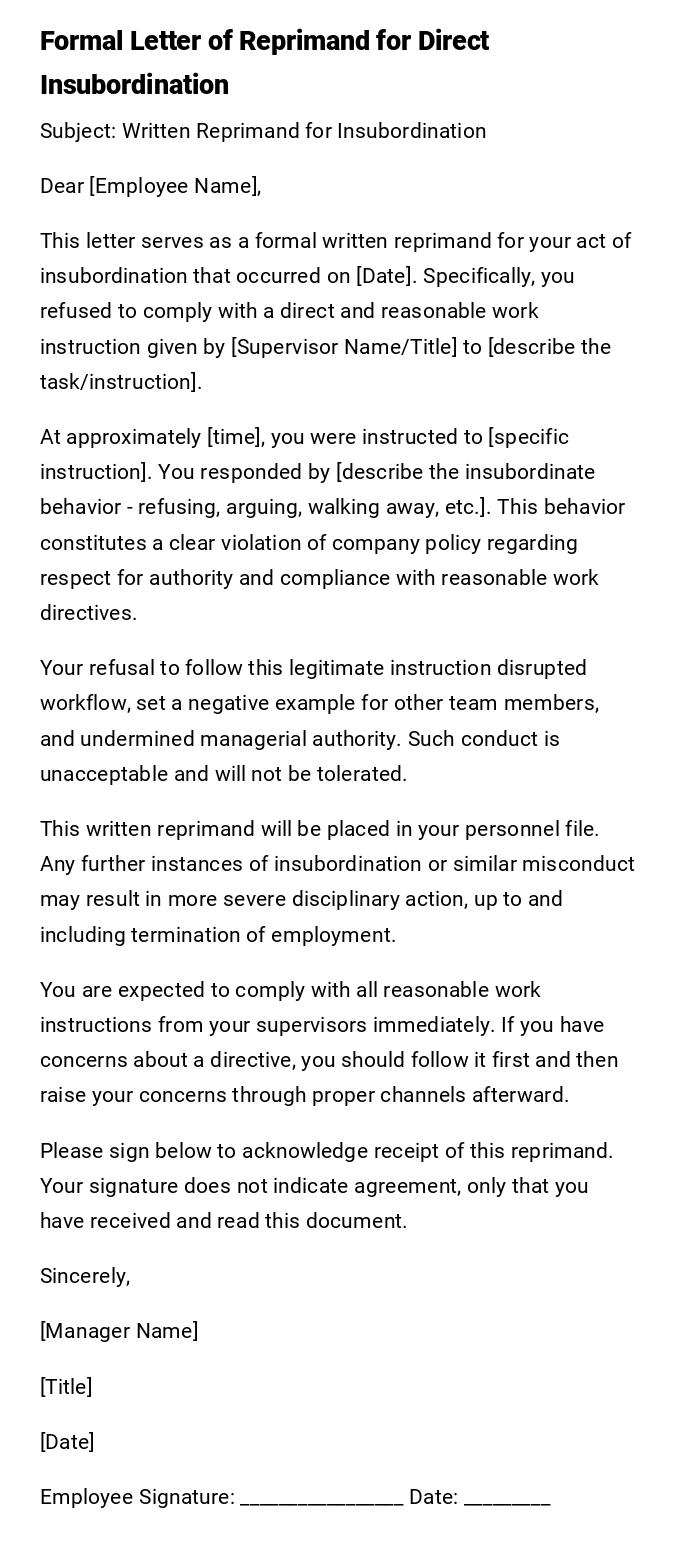
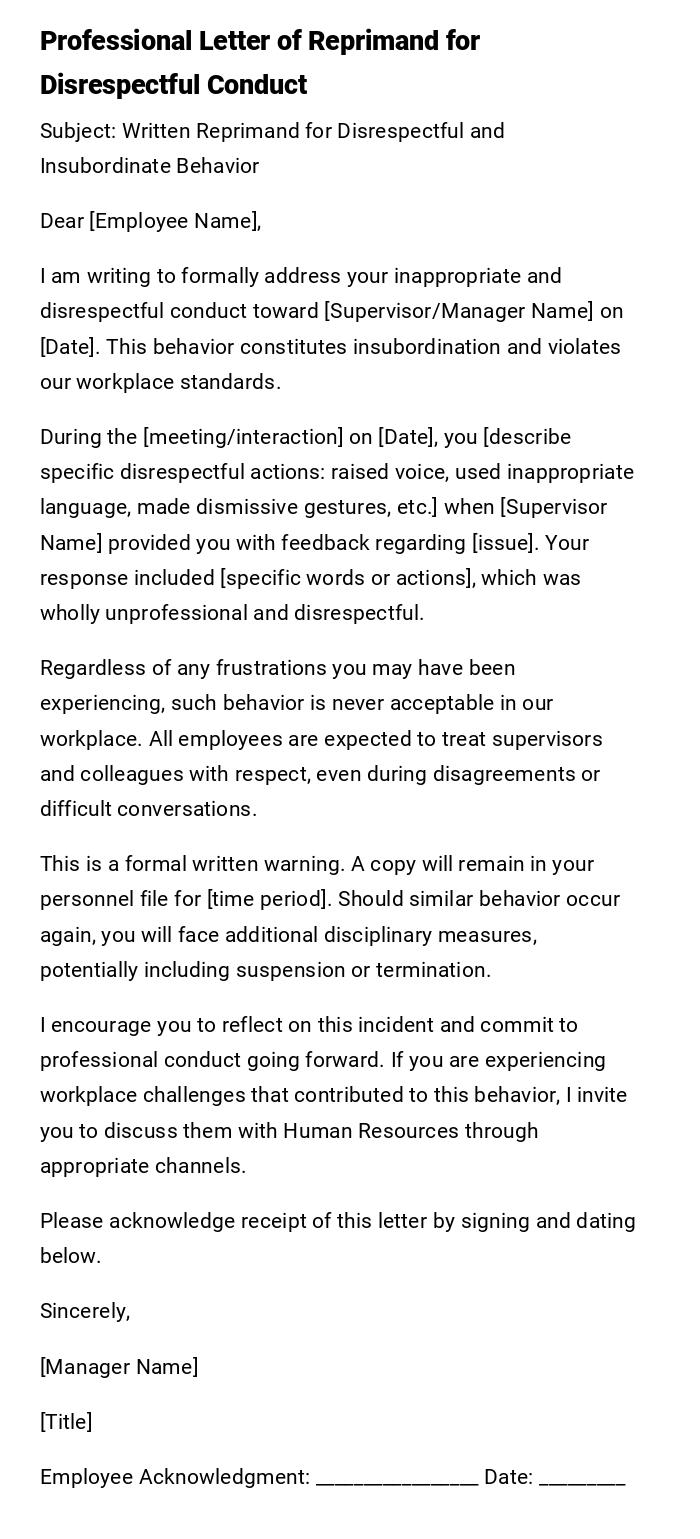
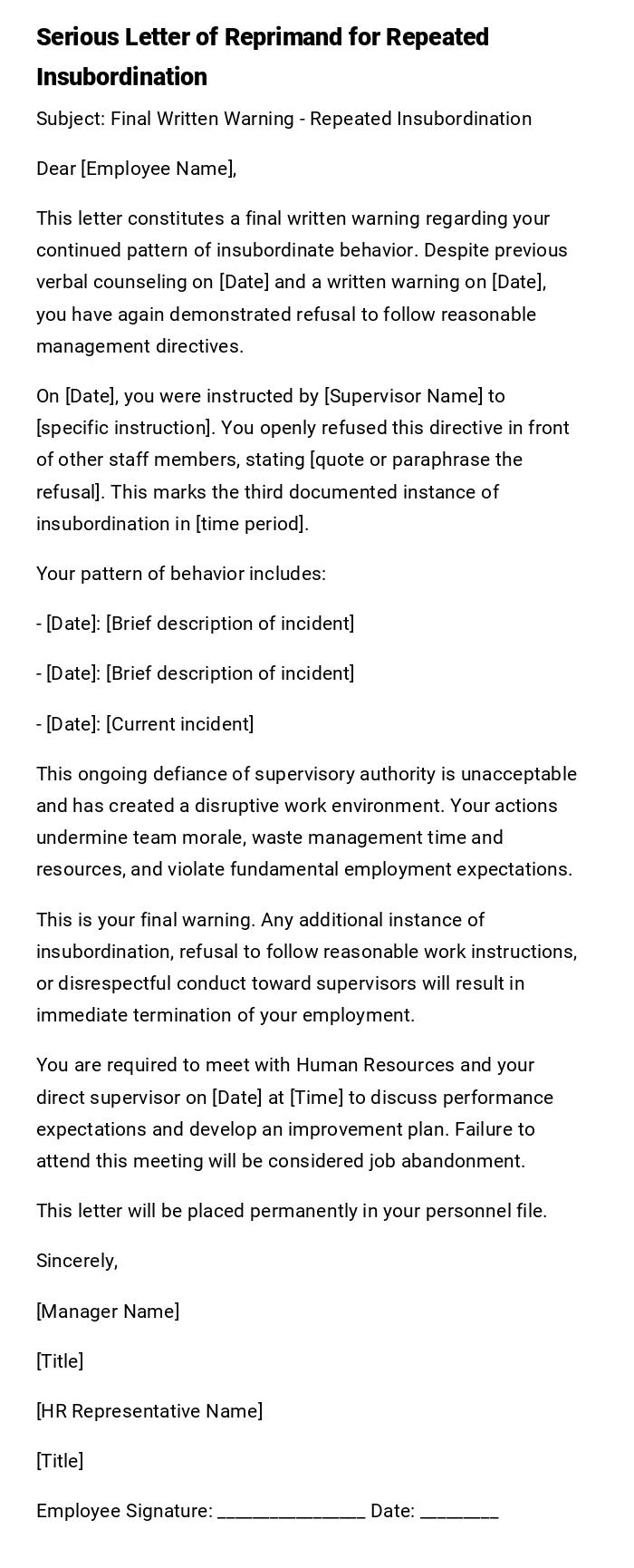
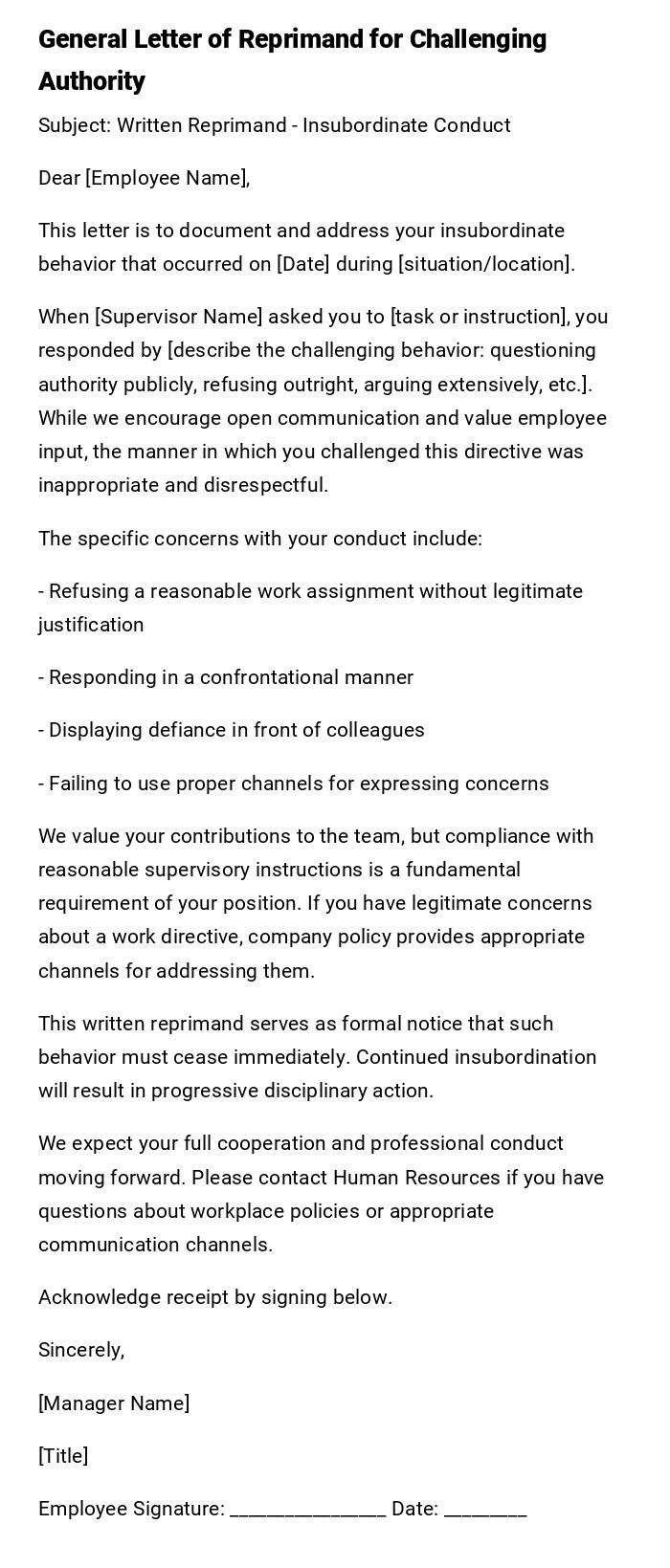
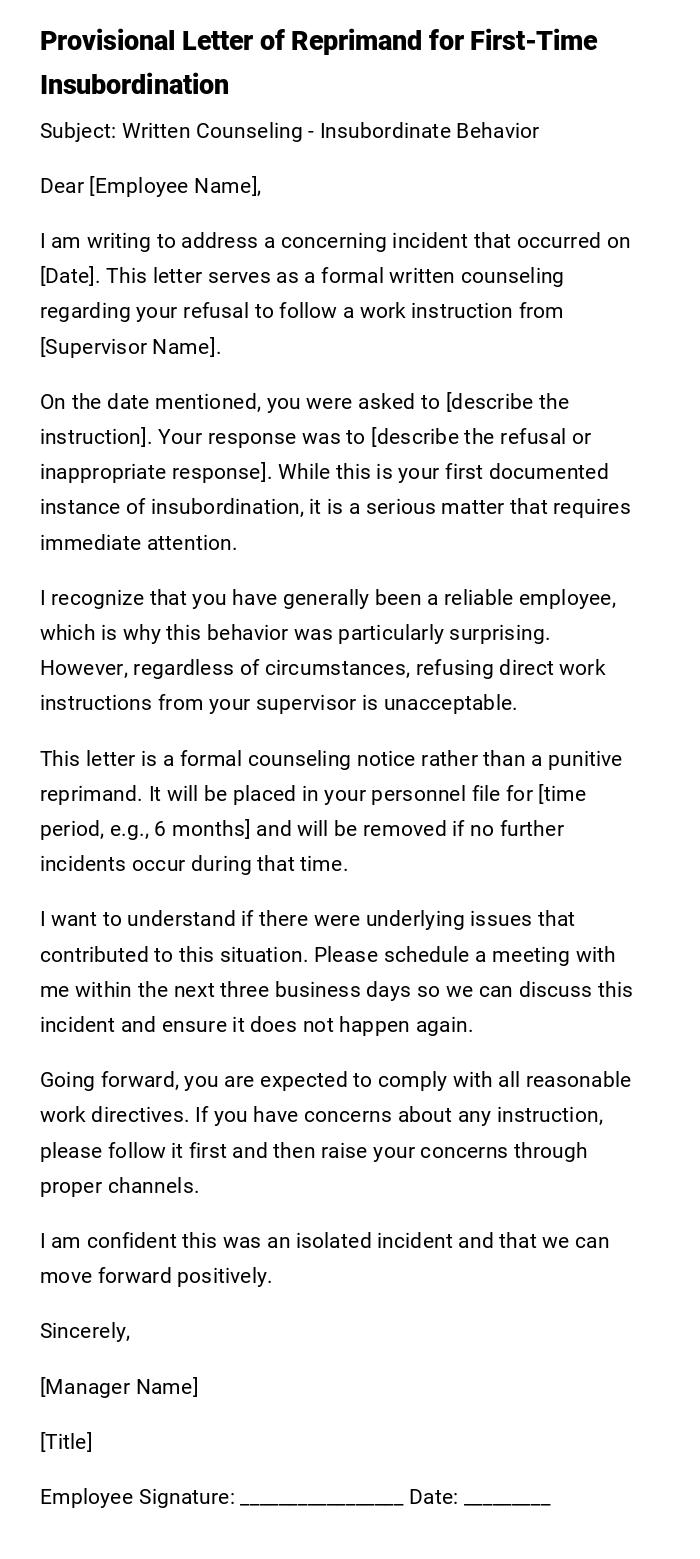
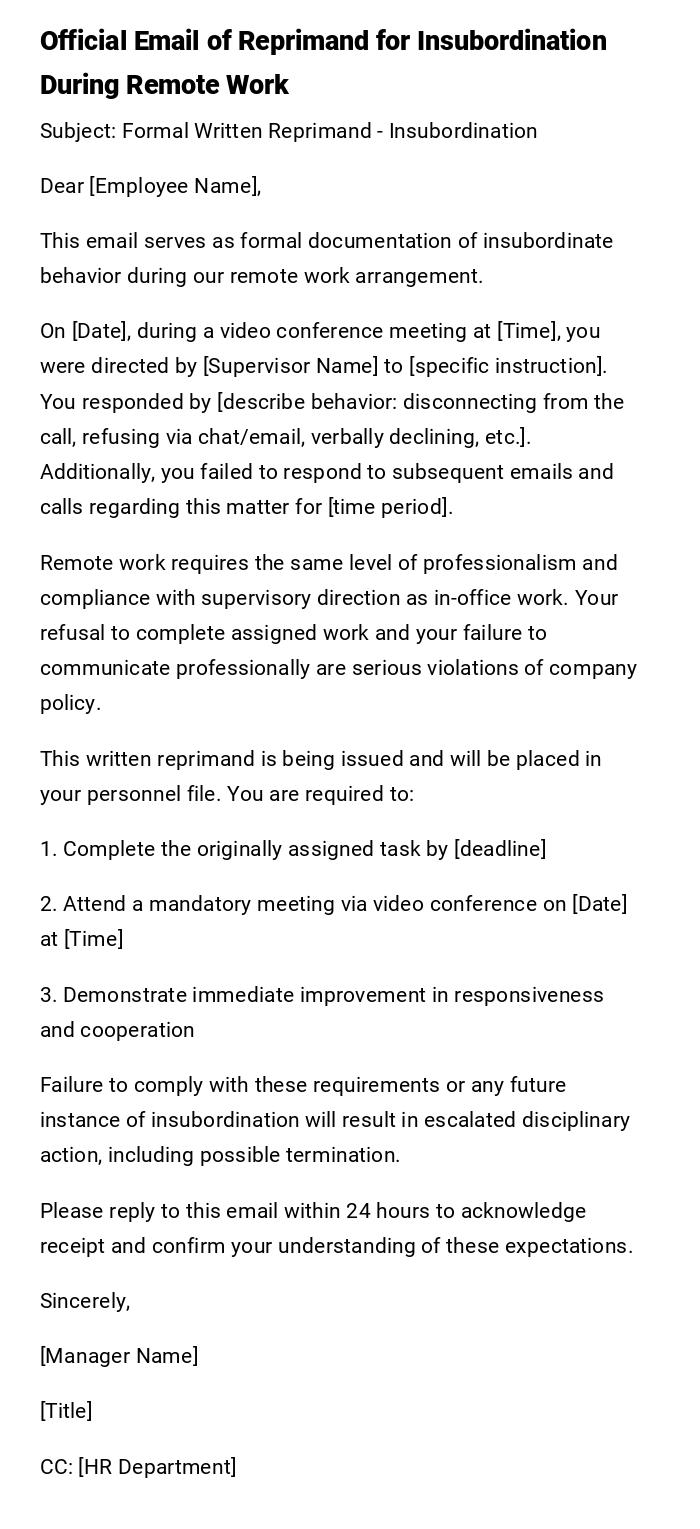
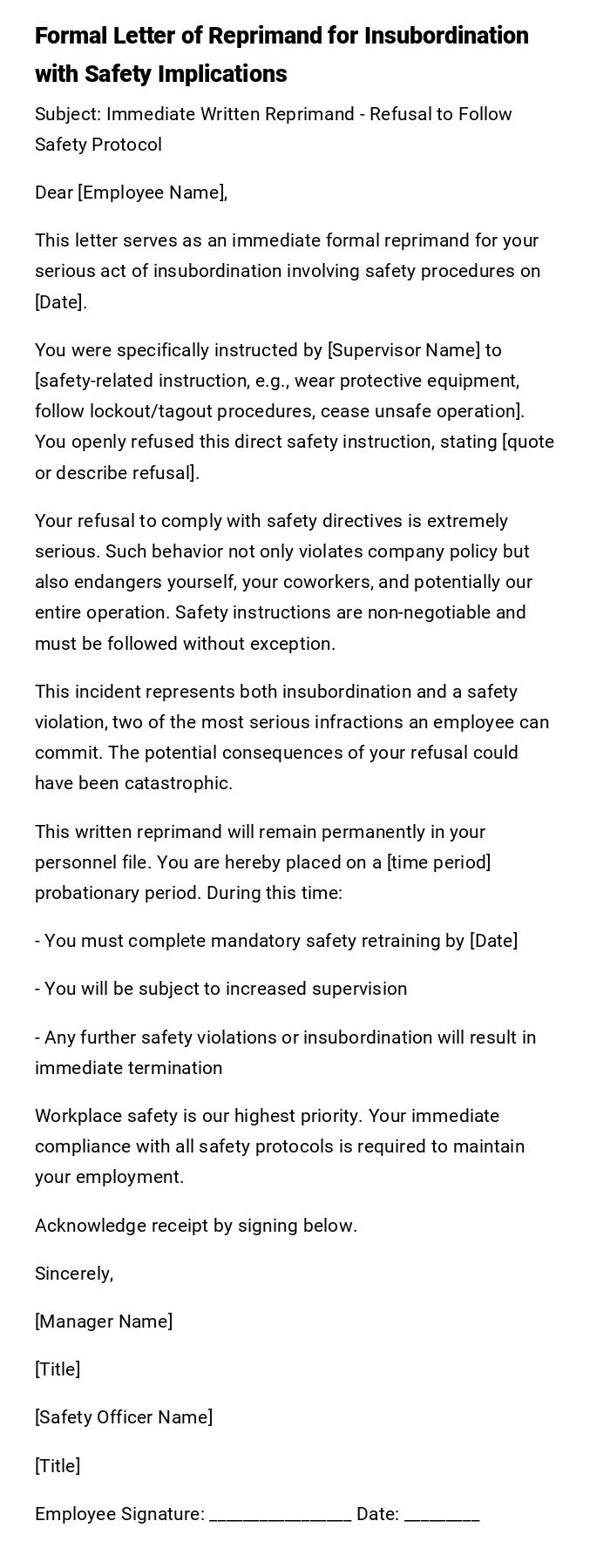

 Download Word Doc
Download Word Doc
 Download PDF
Download PDF